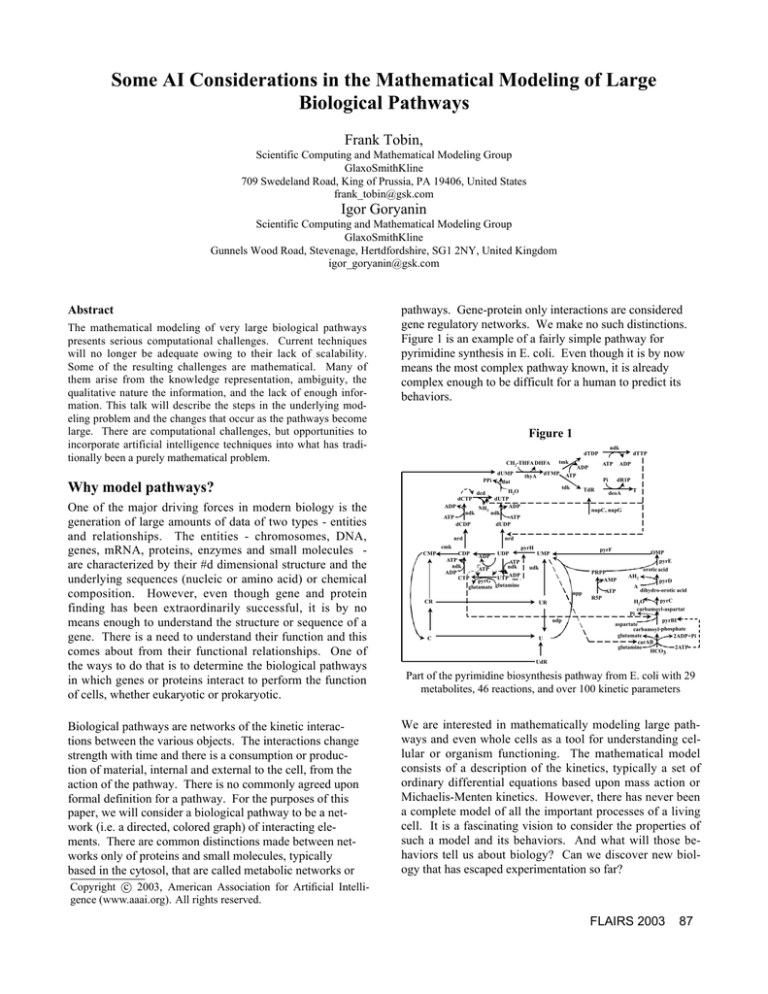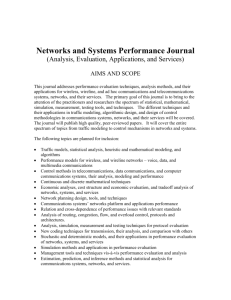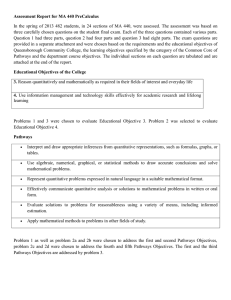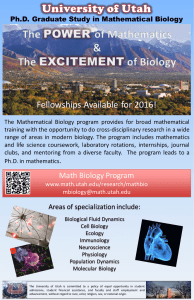
Some AI Considerations in the Mathematical Modeling of Large
Biological Pathways
Frank Tobin,
Scientific Computing and Mathematical Modeling Group
GlaxoSmithKline
709 Swedeland Road, King of Prussia, PA 19406, United States
frank_tobin@gsk.com
Igor Goryanin
Scientific Computing and Mathematical Modeling Group
GlaxoSmithKline
Gunnels Wood Road, Stevenage, Hertdfordshire, SG1 2NY, United Kingdom
igor_goryanin@gsk.com
Abstract
The mathematical modeling of very large biological pathways
presents serious computational challenges. Current techniques
will no longer be adequate owing to their lack of scalability.
Some of the resulting challenges are mathematical. Many of
them arise from the knowledge representation, ambiguity, the
qualitative nature the information, and the lack of enough information. This talk will describe the steps in the underlying modeling problem and the changes that occur as the pathways become
large. There are computational challenges, but opportunities to
incorporate artificial intelligence techniques into what has traditionally been a purely mathematical problem.
pathways. Gene-protein only interactions are considered
gene regulatory networks. We make no such distinctions.
Figure 1 is an example of a fairly simple pathway for
pyrimidine synthesis in E. coli. Even though it is by now
means the most complex pathway known, it is already
complex enough to be difficult for a human to predict its
behaviors.
Figure 1
Why model pathways?
One of the major driving forces in modern biology is the
generation of large amounts of data of two types - entities
and relationships. The entities - chromosomes, DNA,
genes, mRNA, proteins, enzymes and small molecules are characterized by their #d dimensional structure and the
underlying sequences (nucleic or amino acid) or chemical
composition. However, even though gene and protein
finding has been extraordinarily successful, it is by no
means enough to understand the structure or sequence of a
gene. There is a need to understand their function and this
comes about from their functional relationships. One of
the ways to do that is to determine the biological pathways
in which genes or proteins interact to perform the function
of cells, whether eukaryotic or prokaryotic.
Biological pathways are networks of the kinetic interactions between the various objects. The interactions change
strength with time and there is a consumption or production of material, internal and external to the cell, from the
action of the pathway. There is no commonly agreed upon
formal definition for a pathway. For the purposes of this
paper, we will consider a biological pathway to be a network (i.e. a directed, colored graph) of interacting elements. There are common distinctions made between networks only of proteins and small molecules, typically
based in the cytosol, that are called metabolic networks or
Part of the pyrimidine biosynthesis pathway from E. coli with 29
metabolites, 46 reactions, and over 100 kinetic parameters
We are interested in mathematically modeling large pathways and even whole cells as a tool for understanding cellular or organism functioning. The mathematical model
consists of a description of the kinetics, typically a set of
ordinary differential equations based upon mass action or
Michaelis-Menten kinetics. However, there has never been
a complete model of all the important processes of a living
cell. It is a fascinating vision to consider the properties of
such a model and its behaviors. And what will those behaviors tell us about biology? Can we discover new biology that has escaped experimentation so far?
c 2003, American Association for Artificial IntelliCopyright °
gence (www.aaai.org). All rights reserved.
FLAIRS 2003
87
The current cellular models range from relatively small
models of prokaryotes up to yeast, eukaryotic and mammalian cells. There are many models of small pathways
systems, mostly focused on receptor kinetics or signal
transduction. The problem is not always that the connections aren’t known, but that usually the kinetics is poorly
understood. The largest models appear to be based on E.
coli and there are several being developed in different
countries (US, Japan, UK, and Canada). Recently an exciting development has been the creation of the International Alliance on E. coli models (IECA) was announced
(Holden 2002). IECA will bring together the global community of experimentalists and modelers to create an allembracing model of E. coli. The current generation of
cellular and pathway models are being used not only in the
academic community, but have found industrial applications for process design in biotechnology, metabolic bioengineering, pharmaceutical target validation, strain selection and different types of screening procedures.
As more and more data is being generated, the pathways
that can be reconstructed become larger as do the resulting
mathematical models with both more entities and interactions included. Soon expect that many of the current computational approaches will no longer be adequate. These
fall into the falling categories:
∑ knowledge management and representation
∑ analytical techniques for analysis of the model
∑ visualization of the pathway and the simulation
results
∑ numerical simulation
∑ analysis of the simulation results
∑ new knowledge discovery.
The theoretical gaps arise from a lack of adequate theory
for these large meso-scale problems. For example, there is
need to understand what should be the constraints for guaranteeing positive, semi-definite asymptotic and bounded
solutions. There are efficiency gaps that arise from the
scaling up of the problems - both for the numerical simulations and for graph theoretical approaches. Lastly, there is
a need for better software that scales well and is efficient.
In this paper, we will focus on opportunities for artificial
intelligence techniques and not dwell on the larger set of
computational challenges.
The model building process
Constructing the mathematical models is a form of knowledge management - combining biological knowledge with
experimental data in a formal, consistent manner. The
mathematical representation of the kinetics of the interactions, and any mass balances, present a rigorous approach
to providing formality and consistency. Nonetheless, there
is a need to pick reasonable interactions with plausible
parameters.
88
FLAIRS 2003
Modeling building is not a singular event, but recurs as
new data and new biological knowledge accumulate triggering a need to revisit the model and make sure it is still
accurate and to incorporate the new information. Hence,
there is a need to develop a systematic process to facilitate
and automate model development. In addition, given a
particular knowledge representation, there is an additional
need to understand how to trigger this process and understand the resulting differences in the old and new models.
The triggering process should be as automatic as possible
with regard to the integration or checking of data, and to
put the pieces together to create a new pathway model de
novo. This automation requirement implies the use of inference agents examining the existing model, the new data
or information, and deciding on what needs to be done. If
model building were a relatively expensive process, one
would not want to trigger new versions for minor data
changes. A rather mundane consequence of building and
re-building models is the need to have versioning, much as
is done in software engineering.
Model building consists of several straightforward steps.
The first is a bioinformatics exercise to identify which entities are involved - DNA, RNA, proteins, peptides and
small molecules - from interactions with each other, in
various biological processes like transcription, translation,
signal transduction, catalytic cycles of enzymes, and membrane transport. The next step - static model development
- finishes with the identification of the interactions and, at
this point, the model contains only connectivity (topology)
of the interactions, and no kinetic information.
At this
point, some of the connections may be speculative or tenuous and there is a need to include this state of affairs in the
knowledge representation.
Automatic collection processes are use to peruse special
databases, even the literature, to find pathway information.
Because diverse sources are used, ambiguity and inconsistency can result from the particularly daunting problem of
the naming of the various species. While biological names
are often standardized, they do change from time to time,
and there are no guarantees that standardized names are
used. Different names, spelling variants, even misspellings, are a serious problem with potentially drastic consequences to the quality of the model. Biological names are
usually unstructured, but the names of chemical compounds may have more structure - which is both a curse
and blessing. Depending upon context dicholorobenzene
and 1,2-dichlorobenzene may be considered synonymous.
There is a need for a fast and context-dependent fuzzy
spelling dictionary to identify such situations.
The second major stage is to create the kinetic models by
adding the mechanistic ordinary differential equations that
determine the dynamical state of the system at any moment
of time. The next step is to use experimental data, in an
inverse numerical approach to determine the rate constants
in the model. This is largely a mathematical optimization
problem and while there are serious scalability problems,
they will not be dwelled upon here. The third stage of
modeling is to generate the corresponding mathematical
equations for the whole pathway and several XML-based
standards have emerged for this step. SBML(Hucka, Finney et al. 2002) and CELLML (Hedley, Nelson et al. 2001)
are two of the better known ones. After the equations are
generated, numerical simulations based upon integrating
the differential equations and a variety of mathematical
analyses are possible, including asymptotic stability, parameter sensitivity, and linear stability. An analysis of the
simulation results can be used to look for ‘new’ biology.
We have successfully applied this multi-step modelbuilding strategy to successfully create and integrate more
than 14 kinetic sub-pathways of the E. coli metabolism(Goryanin, Demin et al. in press).
AI challenges in pathway modeling
Many of the computational challenges arise from the innate
mathematical nature of the modeling. Some are inherent
from the scalability issue. Yet, if one takes the view that
the modeling process is also a knowledge manipulation
problem, then many other problems emerge. These fall
into several broad categories:
knowledge acquisition and representation
simulation of the model
analysis and visualization of the simulation results
discovering new biology
The modeling process can be viewed as acquiring knowledge, reformulating into a new representation (the mathematical model) and extracting new information from that
model (the simulation). These efforts have been traditionally cast in either a mathematical or a biological perspective. It is our view, that by augmenting the traditional approaches with artificial intelligence viewpoints will only
enhance the modeling effort.
The knowledge acquisition aspect arises from the need to
mine the literature and biological databases to automatically collect kinetic information for pathways. In many
ways, this is a text mining and automated parsing problem.
The difference arises in the need to be able to supply domain specific information to improve generic text mining
approaches.
Recently there has been increasing interest in developing
biological ontologies (Consortium 2000; Consortium).
However, they have largely been focused on genetic information and there is a need to extend them to the larger
realm of cellular functioning. Cellular function encompasses genes, proteins and other kinds of entities. Genes
are spatially inert, but their functioning varies temporally.
Proteins are temporally active and, in many cases, have
complex spatial activity within the cell. For example, a
cell surface receptor may bind a ligand, activate a signal
transduction pathway, then internalize into the interior of
the cell, lose its ligand, and then reappear on the cell surface to repeat the cycle. Both temporal and spatial logics
would be employed.
The resulting network representation will not be perfect.
There will be inconsistencies arising from multiple knowledge sources. There will be incompleteness since we have
only imperfect knowledge of the biology. This may manifest itself as unconnected segments of the topology or parts
of the model that lack kinetic information. Some parts of
the model may be speculative or poorly understood. Such
ambiguity will always be inherent in the models and it is
better to adapt to it than to try to ignore it. Clearly, this
puts a requirement on the knowledge representation and
acquisition to incorporate any ambiguity. However, it is
not ambiguity alone that must be considered - the quality
of the data comes into play as well. Quality information
comes from several sources - the accuracy of the biology
or experimental error from the kinetics experiments.
Numerical simulation has a long history and is a well established discipline within applied mathematics. Nonetheless, in the modeling of such large systems, not all the
problems are mathematical. A planning problem arises
from a subtle aspect of how simulations are performed and
understanding what is truly intrinsic to the models. Models are driven by parameters some of which can be considered as being internal to the model. Internal parameters
occur directly to describe the kinetics and the relationships
in the model. The external parameters describe either the
simulation environment of the situation being simulated or
the biological environment to which the model will be
subjected. For example, kinetic rate constants are internal
to the model, but environmental factors such as temperature, type of nutrient available (carbohydrates or lipids) or
pH of the medium surrounding a bacterium would be external. Implicit external parameters occur as well – integration time step sizes and ranges, choices of thresholds for
integrators, etc. From one simulation run to the next,
some of them may change. The instantiation of the internal and external parameters with explicit values creates a
simulation instance. Parameter choices may not only be
scalar, but vector as well. For example, Monte Carlo sampling of parameter space may be used, or parameters may
be ‘sweeped’ over a range of values for sensitivity calculations. The choice of one or more parameter values and the
methods of those choices, form the basis of the concept of
simulation ‘scenarios.’ A scenario is the raison d’etre for a
simulation run and may constitute more than one related
numerical simulation. Since scenarios have purposes, they
encode the goals of the resulting analyses. In this way,
they act as automated planning for the following analyses.
FLAIRS 2003
89
There is a need for a formal description language for developing scenarios , automated analysis planning, and the
execution of the analyses.
To date, most simulations have been numerical integrations
of differential equations - continuous, discrete, or stochastic. In the language of fuzzy logic, they depend upon
‘crisp’ quantities. Yet, often our knowledge of the equations is not crisp, but ambiguous. It would be desirable to
represent the ambiguity throughout the integration from all
the sources of the uncertainty - error, biological knowledge, rate equations, rate constants, and initial conditions.
There are few good techniques for incorporating such uncertainty in numerical integrations. Integrators using interval analysis (Moore 1966; Kearfott and Kreinovich 1996)
are limited to only handling uncertainty in the initial conditions (reference). Much more is needed. An extension
of fuzzy arithmetic to fuzzy integration is needed. A numerically stable, robust and accurate integrator based on
fuzzy arithmetic would be a major advance. It would also
represent an intriguing blend of artificial intelligence and
numerical analysis.
There is yet another synthesis needed - integrators that
blend qualitative and quantitative simulation. Such an approach would be a tool to get around the incompleteness
issue in adding kinetics to static models. Oftentimes,
rough kinetics can be ‘guessed’, but must be expressed in
exact quantitative ways as if there were no qualitative aspects. Having a hybrid integrator that combines quantitative integration with qualitative simulation would allow
models to be larger than if just ‘pure’ quantitative approaches were used. It would be obvious which parts of
the model and results were qualitative. Let’s go further
and ask for an integrator that does it all:
exact quantitative - continuous, discrete, stochastic
fuzzy quantitative
qualitative
This is clearly a challenging and ambitious goal - one that
will not only advance pathway modeling, but other fields
of biological simulation as well.
One of the scalability issues that arise is the ability of humans to analyze the results of the simulations. As pathways model become larger, it no longer is feasible to scan
the resulting time curves either for validation, comparison
or knowledge discovery purposes. Tens of thousands of
time curves present a daunting problem. Comparing that
many time curves across multiple simulations makes the
problem even more harrowing. Better tools are needed, in
conjunction with the scenario concept, for automating
these searches. There are elements of pattern recognition
and data mining, but more is needed. The scenarios set the
goals, the model or the larger biology sets the context, for
the examination. In addition, these knowledge domain
90
FLAIRS 2003
constraints must somehow be integrated to build better
analyzers.
Perhaps the most intriguing aspect of simulation analysis,
is the search for new knowledge - new biology. If we take
the view that a model is good, then we should be able to
find knowledge that has escaped our attention so far. In
fact, one can construct a gedanken experiment along these
lines. Suppose we had a perfect model - complete, consistent, no error, and no ambiguity. Could we rediscover
biological pathways? Could be rediscover the known phenomena associated with these systems? Let’s take the experiment further and drop all labels. We know the entities
in the model only by their actions. Could we rediscover
the concepts of protein or gene? Our ‘real’ models are not
perfect - far from it. So our attempts are knowledge discovery are going to be harder. Nonetheless, we should still
be willing and able to make the attempt. This is where
good tools for this type of a knowledge discovery enterprise are sorely needed.
Similar to knowledge discovery is the model validation
problem. Typically, models are validated through the parameter determination process. To find the kinetic parameters, an inverse problem is solved - parameters are
chosen such that some type of optimization objective function is minimized. The most common objective function is
usually an Lp norm between the model predictions and
experimental kinetic data. One of the many potential
problems is that many interactions are not pairwise, and
many entities simply could be missing. As a result, many
hypothetical variables would be needed to fit the data,
leading data overfitting and the inability to interpret the
hypotheses in a biological meaningful way. So, the model
is validated in the sense that its predictions predict results
‘close’ to the experiments. There are several problems
with this approach. It is a ‘necessary’ method, but by no
means a ‘sufficient’ one. Part of the problem is that experiments measure only a very small subset of all the entities in the model. Therefore, while a good fit may be obtained, there is no a priori guarantee that all the entities are
well represented. Additional problems like noise and numerical ill-posedness come into play as well. Therefore,
model validation is not as accurate or complete as desired.
As a rule if the model is good, then the knowledge that
went into its building should be extractable from it. The
fitting of experimental data does not address this. So we
need tools for validating the model by comparing the biological knowledge that went its building with the simulation results. In one sense, this is very similar to the problem of software validation and the concept of assertion
testing for proving correctness. Validation can be considered as a form of forward chaining inference :
input_biology fi simulation_results
The challenge is to be able to represent the biology in a
formal representation in order to make the inference
checking work. The biology is both temporal and spatial
and may use rules that encompass all spatial positions or
all times. The representation must be expressive for events
occurring on these two (concentration and time) or five
(concentration, position, time) dimensional surfaces. The
basic constructs involve surface shape characteristics (e.g.
extrema, saturation, decay, etc.) or time events (e.g. positions of extrema or zeroes). A trivial example would be to
require that all enzyme concentrations, at all positions, at
all times would be positive semi-definite. These formal
assertions can be used for a variety of purposes:
plausibility - the biology behaves as expected
diagnostic - finding out why the system behaves as
it does
speculative - finding phenomena that is postulated
or rarely observed
In this way the assertion checking serves as the eyes-andears of the modeler to find inconsistencies, validation failures, or to discover new biology.
Goryanin, I., O. Demin, et al. (in press). Applications of
Whole Cell and Large Pathway Mathematical Models in
the Pharmaceutical Industry. Future Perspectives in Metabolic Profiling. B. N. Kholodenko. Wymondham, United
Kingdom, Horizon Press.
Hedley, W. J., M. R. Nelson, et al. (2001). "A short introduction to CellML." Philosophical Transactions of the
Royal Society of London A 359: 1073-1089.
Holden, C. (2002). Alliance Launched to Model E. coli.
Science. 297: 1459-1460.
Hucka, M., A. Finney, et al. (2002). "The Systems Biology
Markup Language (SBML): A Medium for Representation
and Exchange of Biochemical Network Models." Bioinformatics.
Kearfott, R. B. and V. Kreinovich (1996). Applications of
Interval Computations, Kluwer Academic Publishers.
Moore, R. E. (1966). Interval Analysis. Englewood Cliffs,
New Jersey.
A lot remains to be done in the computational toolkit for
modeling biological pathways. the challenges are in many
disciplines - biology, computational biochemistry, mathematical analysis, software development, and in the general
understanding of the knowledge system. It will take multidisciplinary efforts to tackle this difficult, but ultimately
rewarding area. Development of these modeling systems
for virtual experimentation will take on greater importance
as the biological systems become more complex. Currently the development of whole cell E. coli has already
strained the existing computational tools (Goryanin, Demin
et al. in press). Such models will become more sophisticated and will become ever more important in pharmaceutical, medical, and biological research.
ACKNOWLEDGMENTS
The authors would like to thank all of our collaborators
who are involved in the E. coli whole cell modeling effort
at GSK - Nick Juty, Hugh Spence, Serge Dronov and Oleg
Demin at Moscow State University.
REFERENCES
The Gene Ontology Consortium, (2000). "Gene ontology
tool for the unification of biology." Nature Genetics 25:
25-29.
The Gene Ontology Consortium, (2001). "Creating the
gene ontology resource: design and implementation." Genome Research 11: 1425-1433.
FLAIRS 2003
91





